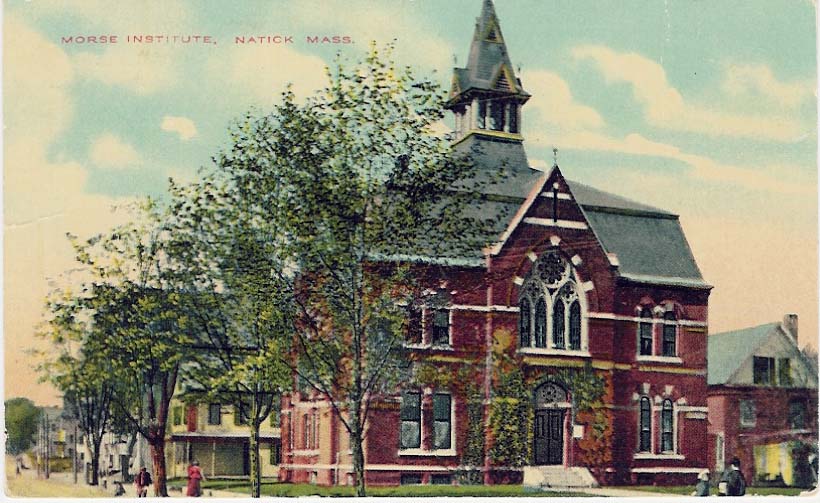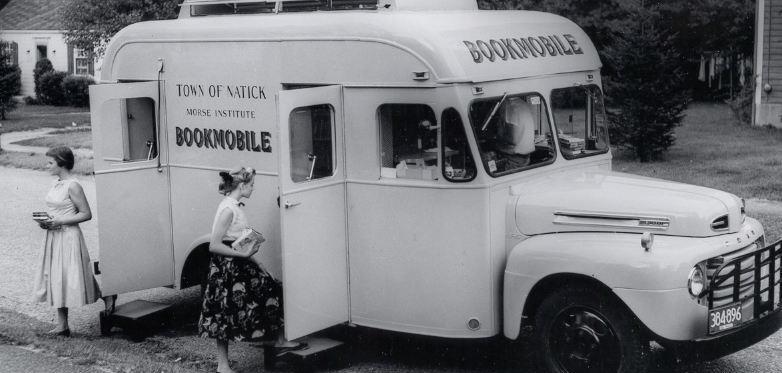
The Morse Institute Library opened in 1874 with 7,300 books, “to disseminate learning and intelligence” to the residents of Natick.
The Morse Institute Library: Past and Present
On the afternoon of December 25, 1873, the dedication of the new Morse Institute, a public library for all of the people of Natick, was held in Concert Hall on the third floor of Clark’s Block. It was the culmination of a decade of work managing the estate of Mary Ann Morse (1825-1862), who, “having a strong and abiding interest in the welfare and prosperity of my beloved native town,” willed her estate to the town “for the purpose of creating a public library.”
The Boston Daily Globe at the time described it as 44 by 56 feet of brick trimmed with a granite Gothic design, the inside finished in black walnut and ash, and with elaborate stained glass windows. The building cost $30,000. The lower floor was for offices and workrooms, and the upper floor was for the library and reading room. The building originally had a steeple on the roof, but this was removed, most likely due to structural concerns.
Details of the life of Mary Ann Morse are limited. Born in 1825, she likely did not receive anything beyond a grammar school education; the Natick High School was not established until 1852. There is no mention of her attending any available "select" schools. She remained at home, took care of her elderly parents until their deaths around 1850, and was semi-invalid for many years.
Morse family members were the largest landowners in Natick for several generations. Mary Ann’s father, Ruel Morse, initially built a small house, and later a larger brick home when he prospered, on the site of today’s modern library. In the early 19th century, Natick’s 700-800 residents mainly were hard-working, frugal farmers. Pegan Brook ran across Ruel’s farm, and he built a dam across the stream to generate the power to operate a trip hammer to manufacture plows. Later, he built a blacksmith shop. His wife reportedly helped him by painting and marking the plows. The couple had three children: Clarendon (who died young), Darwin, and Mary Ann.
Mary Ann Morse’s Vision for the Library
Mary Ann Morse’s will was explicit in describing the design of the building, its location, purpose, operation, and financing. “Said Institute shall be named and called the Morse Institute, and its object and purpose shall be to promote and disseminate learning and intelligence among the inhabitants of said Town by means of a Library to be composed of the best standard works in the various departments of science and literature.” Also stipulated was that the structure would be built on the corner of Central and Washington streets, “being the spot on which my Brick Dwelling House now stands, which shall be forever kept as a site for said Institute.” Additional stipulations in the will were that the town was to pay for the care of the building and the librarian’s salary. However, the library was not to be another town department; the property was owned by an independent corporation organized under a state charter, called the Morse Institute in Natick, and held in trust by a board of five “men of probity and learning.”
At the annual town meeting of 1863, various articles concerning the adoption of the will were on the town meeting warrant. A committee was formed to decide whether the bequest was welcome and what expenses would be assumed by the town. This committee concluded that it benefited the town to accept the terms of the will, approval was voted, and five trustees were elected to administer the will.
One year later, the town opted to reconsider its vote. The value of the estate was in question, and a lawsuit had been brought against the trustees by the guardian of a nephew of Mary Ann. A motion was passed at the 1864 town meeting to reconsider the previous year's vote. The matter was brought before the Supreme Judicial Court to decide on the course of action to be taken by the town and the trustees. Ultimately, the bequest was declared a public charity and, having been accepted, could not be renounced.
Earlier Libraries in Natick
The Morse Institute was one of many ventures to establish a library in Natick. In the Morse Room today, there is a relic of the first circulating library established in the early 19th century: its 94 volumes were then housed in an old bookcase in the home of Samuel Morse, grandfather of Mary Ann Morse. These books eventually became scattered, and the bookcase was found in an old house and given to the Morse Institute. In the library restoration and reconstruction of the 1990s, the bookcase was restored for display. The Citizens’ Library was organized in 1847 with Henry Wilson as one of the original shareholders, and this eventually became the Natick Town Library, accepted by vote of the town meeting in 1857. The Massachusetts legislature had authorized towns to raise money to create public libraries in 1851. This Town Library, with about 4,000 volumes, was ultimately placed under the management of the Morse Institute trustees. The Bacon Free Library in South Natick was funded separately in the will of Oliver Bacon and opened in 1880.
By 1872, the trustees reported that Mary Ann’s bequest had sufficient funds to build a library. It was completed in July 1873 at the location of her house, which was moved to Clarendon Street. A reserve fund was created according to the terms of the will, and $9,000 was used to purchase books to add to those transferred from the Natick Town Library. The Morse Institute offered about 7,300 books when it opened on January 1, 1874.
It is enlightening to read the librarian's annual reports about the gradual increase in circulation and the number of patrons using the new library. There was greater interest in history, biography, and science books than other subjects. Two printed catalogs were produced by 1900. The library used a fixed location system of arranging books on the shelves, which was not conducive to open shelf access. In the first decade of the 20th century, the Morse Institute and many of the libraries in this area adopted the Dewey Decimal Classification system, which called for the relative placement of like subjects on the shelves. This system promoted access to open stacks for browsing.
In 1900, a gift of $5,000 allowed for creating a “Library and Reading room specifically adapted to the needs of young people.” The library enjoyed increasing patronage, and its collection had more than doubled. In the 1920s, a campaign was begun to renovate the building, completed in 1928 with a combination of town funds and bequests. The children’s department was moved to the second floor, and the main library and reading room were relocated to the main floor with a new, enlarged stack shelving area. A World War I memorial, which the town had long desired, was created at the entrance. The 1930s were a time of substantially increased usage, as is now commonly observed in troubled times. Book demand could not be adequately met, and staffing was reduced slightly. Branch library services were created in two schools, and the staff acted as school librarians for the high school and junior high school and delivered books to hospital patients.
In the 1950s, the library acquired two bookmobiles. One was for weekly school visits during the school year, and the other was for visits to the neighborhoods further from the town center. This outreach service continues to this day. In the 1960s, the library needed another addition. This one provided an enlarged reference area with room for a growing collection, a new teen area, a new children’s library, a bookmobile garage and office, increased storage in the basement, and a redesign of the front lobby and circulation desk. The look of the library changed dramatically. In the following decades, usage continued to grow, more professional services were added, and the library joined the networking movement in the MetroWest area to improve service to all library users.
Modern Expansion at the Morse Institute
The 1980s brought a new need for expansion. The budding technology revolution necessitated a new design. It was clear from just a few computers in the building that superimposing them on the existing library style would not be possible. There also was a dire need for more book shelving, more room for meetings and children’s activities, better storage of historical materials, and more offices for staff. By the time the new building was approved and designed, the upper floor of the existing building had been condemned. Lengthy and intense planning for the renovation and redesign got underway, and with the support of the Town Administrator, money from the Natick Mall tax revenue was voted to fund this project. In the years following, the library raised over a million dollars from individual donors, the Friends of the Library, and area businesses to furnish and equip the new building. The Library was the first stage in a downtown building plan, followed by a new Town Hall and public safety building. Groundbreaking for the new building was on March 9, 1995. Library operations had relocated to temporary quarters at 17 West Central Street after most of the collection was moved to various storage locations. In April 1997, the library reopened and was rededicated.
The renovations preserved the 1873 building and its place in Natick’s history. The new additions enabled the library to be successful in the 21st century. Public space was tripled, meeting spaces increased, children’s and teen departments had larger areas, and internal technological capabilities expanded in anticipation of the growing use of electronic services. The Morse Institute continued to fulfill the vision of a community space dedicated to preserving the past and providing for future needs.
return to 19th-century menu:
click here
Selected sources and additional reading:
Natick History Museum Collections
Morse Institute Library



